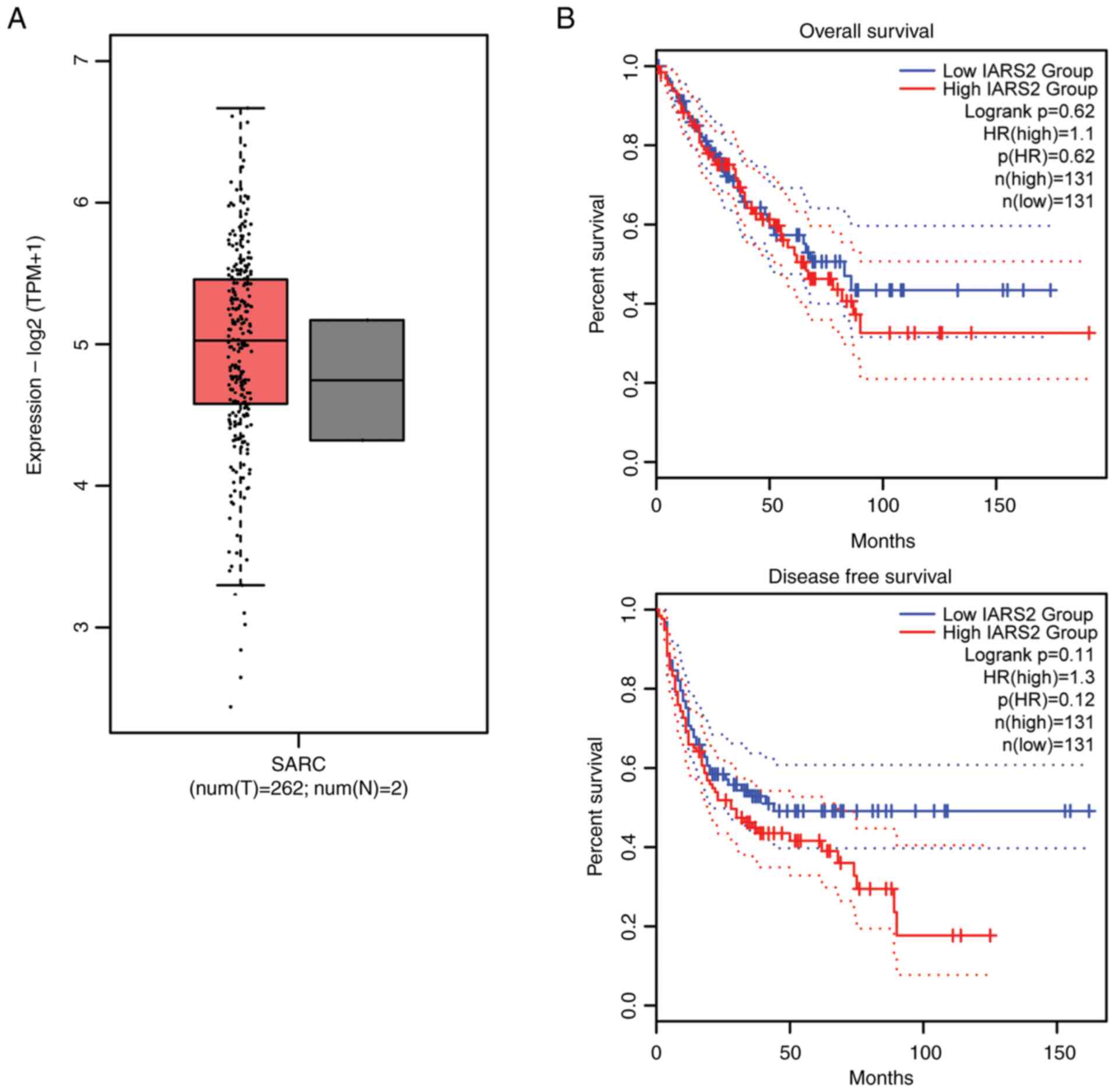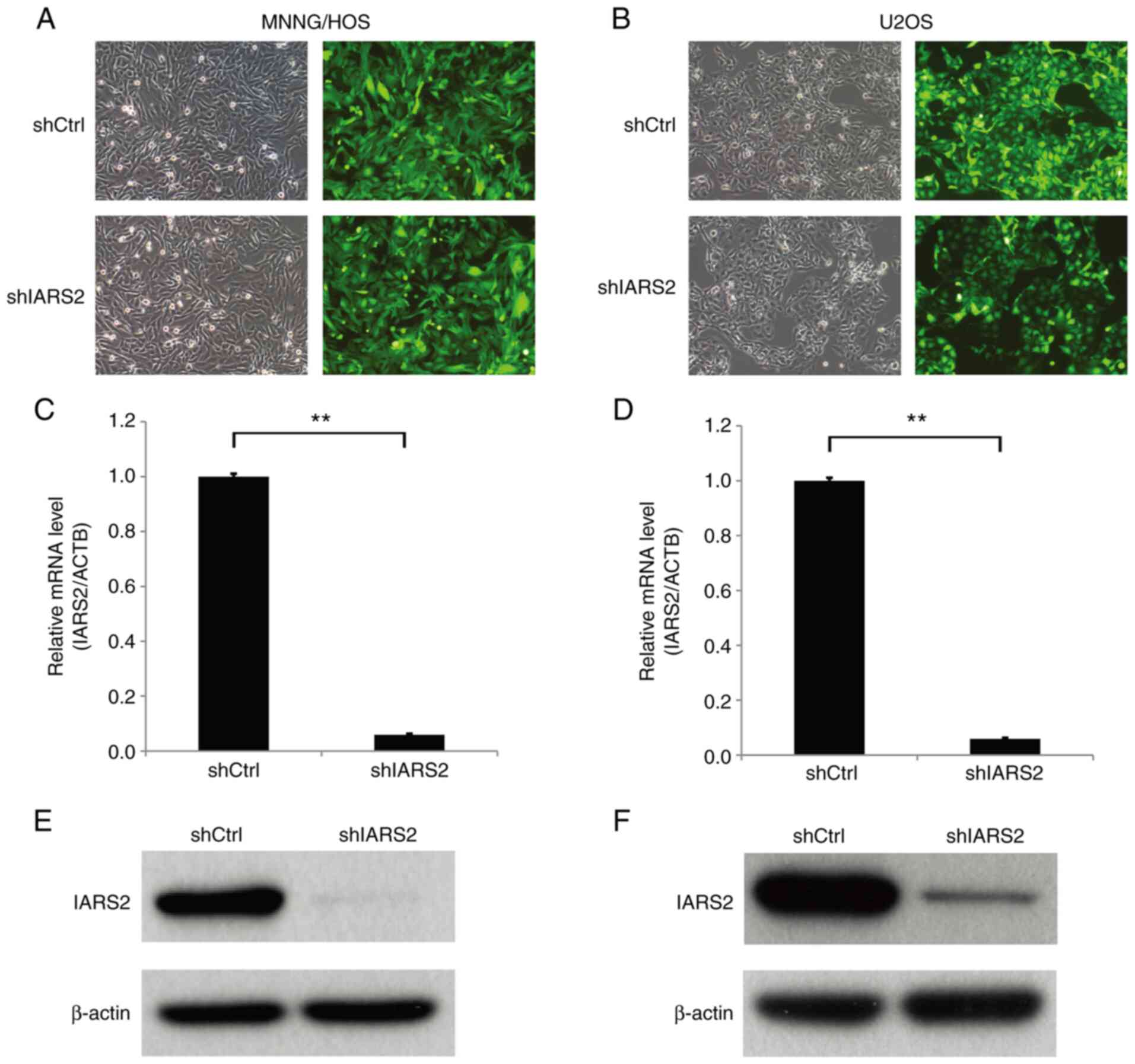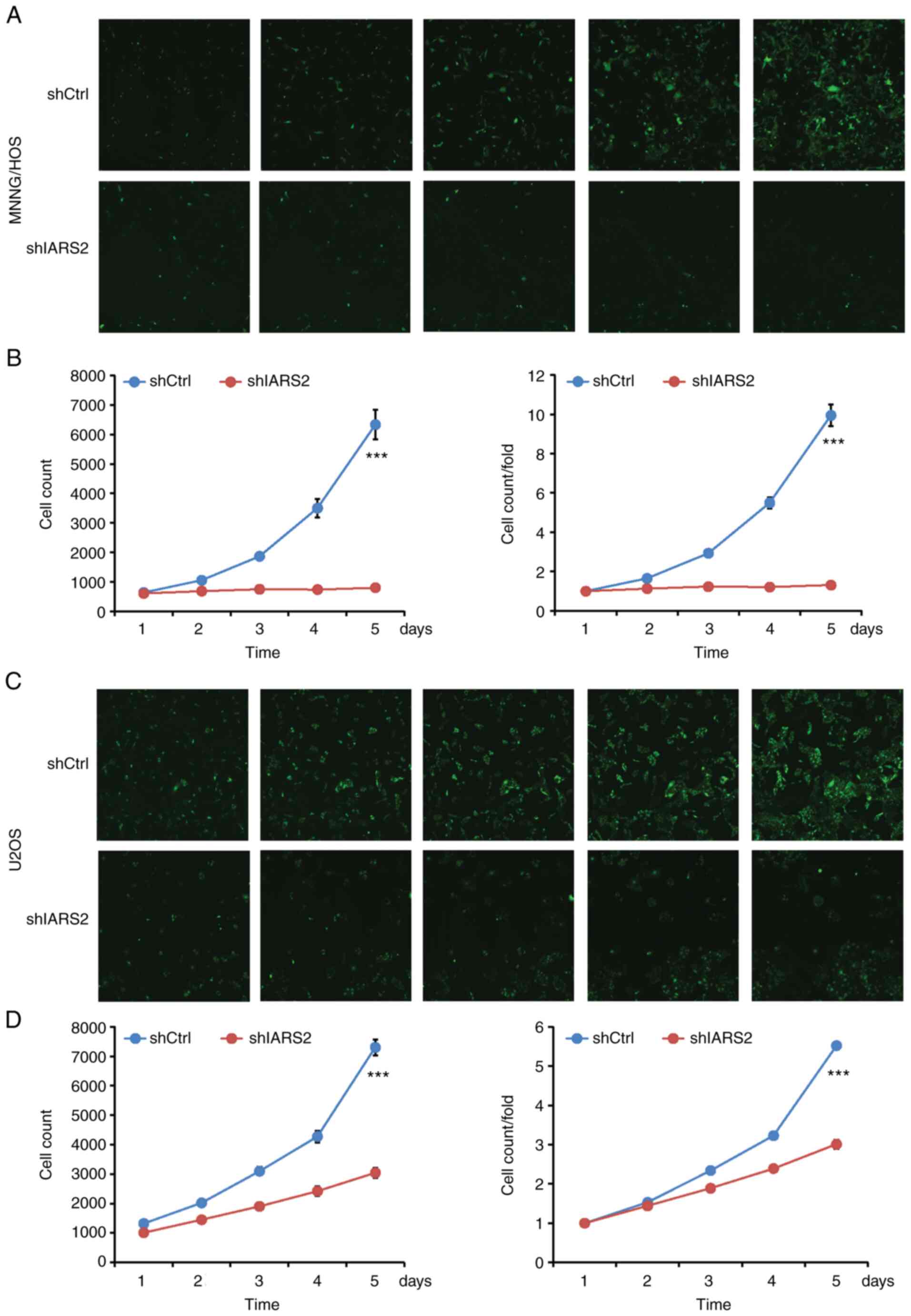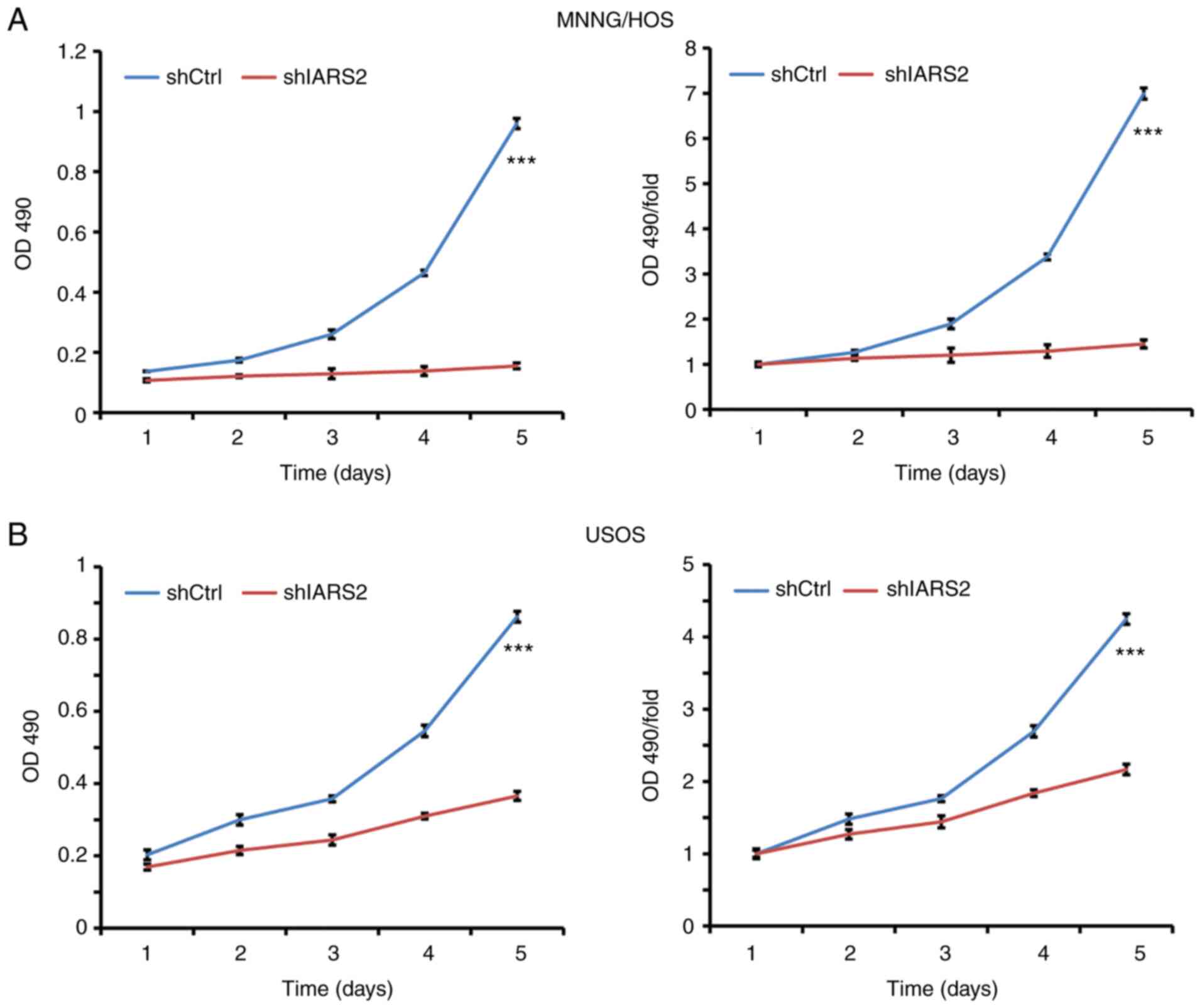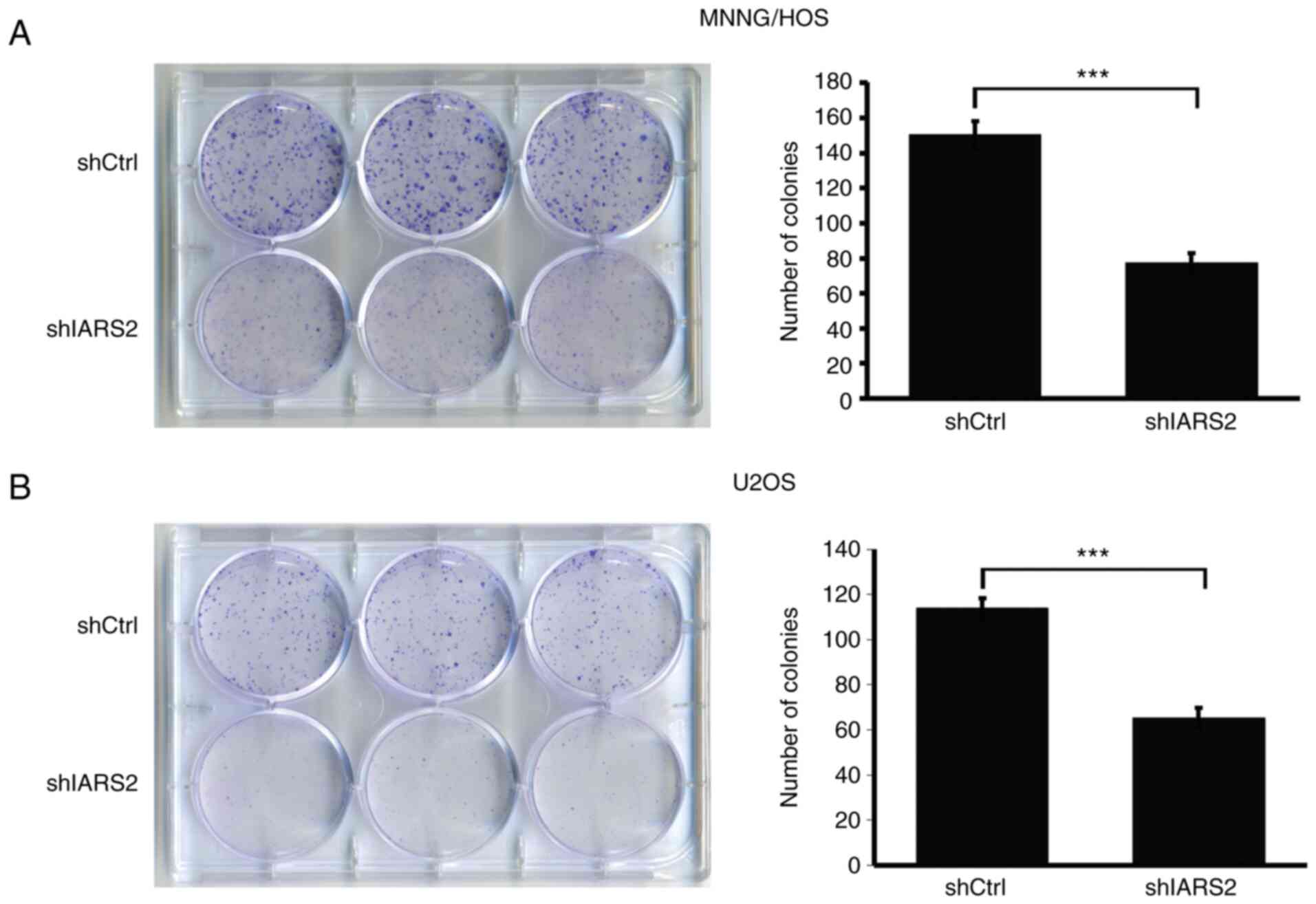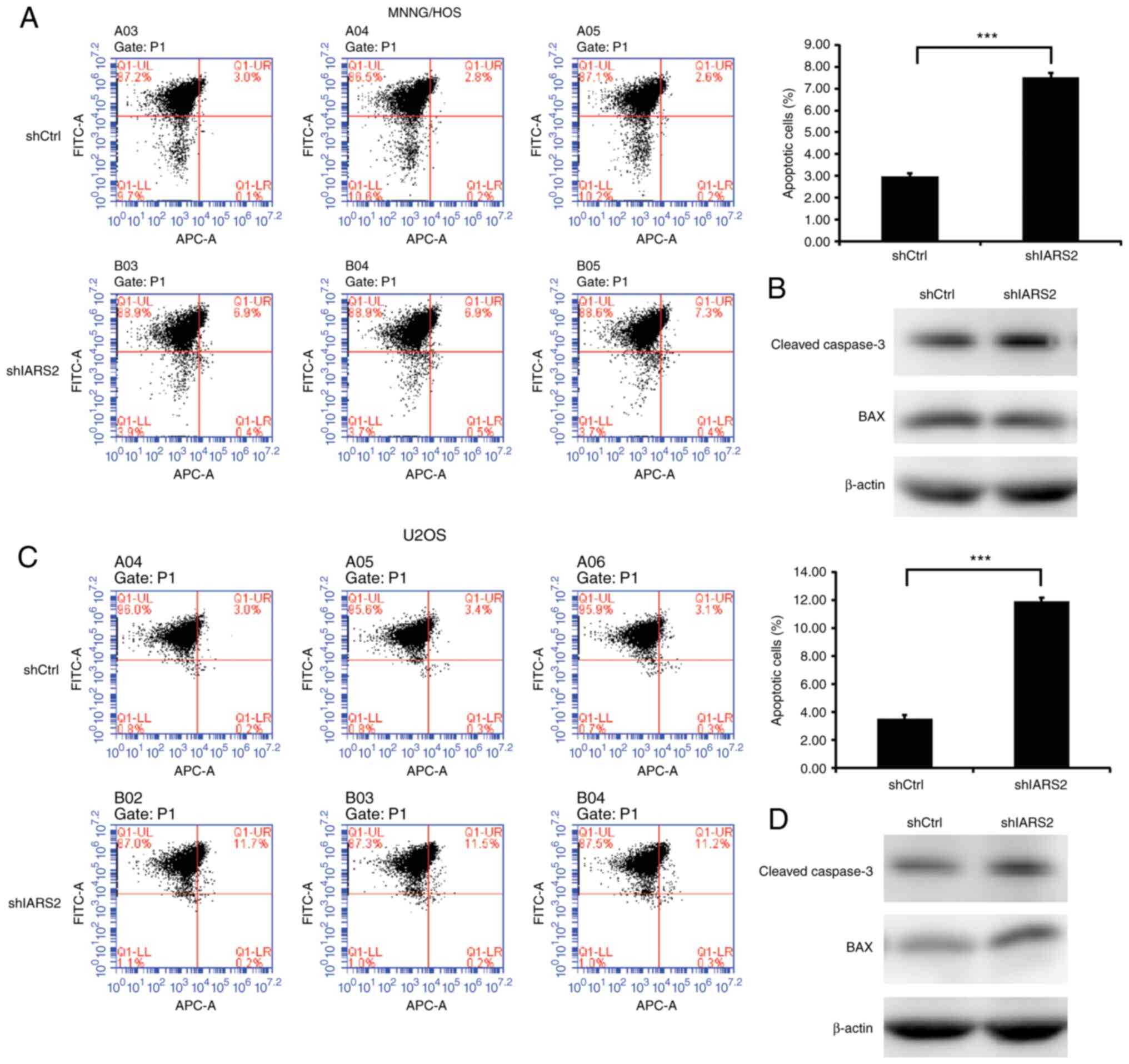Lentivirus‑induced knockdown of IARS2 expression inhibits the proliferation and promotes the apoptosis of human osteosarcoma cells
- Authors:
- Published online on: June 15, 2022 https://doi.org/10.3892/ol.2022.13382
- Article Number: 262
-
Copyright: © Liu et al. This is an open access article distributed under the terms of Creative Commons Attribution License.
Abstract
Introduction
Osteosarcoma (OS) is the most common type of primary malignant bone tumor, which generally occurs in adolescents between 10 and 20 years old, and is associated with high malignancy and a poor prognosis (1,2). Once OS occurs, due to its aggressive growth, patients have to receive large doses of preoperative and postoperative chemotherapy, which places a great psychological and physical burden on the patients. Certain cases of OS are resistant to chemotherapy and the tumors continue to grow rapidly. The limb of the patient may need to be amputated, lung metastases may occur and the mortality rate remains high (3,4).
The treatment of OS has not been significantly updated in the past four decades (5,6). Numerous targeted drugs are improving the treatment of other tumors, but their development for the treatment of OS is progressing slowly, highlighting the urgent need to study the mechanisms driving the occurrence and progression of OS (5). If essential genes that play key roles in the growth of OS can be identified, effective OS-targeted therapy drugs could be screened or developed.
In mammalian cells, protein synthesis requires the participation of amino acid synthetases, such as aminoacyl-tRNA synthetases (ARSs), which can transfer amino acids to tRNAs (7). ARSs have been reported to be abnormally expressed in numerous tumors, such as colon cancer, hepatoma and breast cancer (8). Previous studies have revealed that ARSs play important roles in triggering cancer cell proliferation, differentiation and RNA splicing (9–11). Isoleucyl-tRNA synthetase 2 (IARS2), also known as isoleucine-tRNA ligase, catalyzes the aminoacylation of tRNA through its cognate amino acids and it is located in mitochondria (9). IARS2 mutations have been identified in patients with cataracts, growth hormone deficiency with short stature and peripheral neuropathy (12). In addition, IARS2 has been reported to be overexpressed in numerous types of cancer, such as glioblastoma, non-small-cell lung cancer (NSCLC) and gastric carcinoma (GC) (13). IARS2 knockdown inhibits cell proliferation and colony formation, and promotes apoptosis in NSCLC and GC (14–16). However, to the best of our knowledge, the expression and function of IARS2 in OS have not been reported.
In the present study, the expression of IARS2 in OS was analyzed using the Gene Expression Profiling Interactive Analysis 2 (GEPIA2) database. In addition, the function of IARS2 in cell proliferation and apoptosis was evaluated by knocking down its expression in OS cell lines, which is helpful for exploring potential therapeutic strategies for OS.
Materials and methods
Cell culture
MNNG/HOS Cl #5 [(R-1059-D) (MNNG/HOS)] and U-2 OS (U2OS) cell lines were purchased from Shanghai Institutes for Biological Sciences, Chinese Academy of Sciences. MNNG/HOS cells were cultured in MEM (Gibco; Thermo Fisher Scientific, Inc.), and U2OS cells were cultured in DMEM (Gibco; Thermo Fisher Scientific, Inc.) supplemented with 10% fetal bovine serum (FBS; Gibco; Thermo Fisher Scientific, Inc.) and incubated at 37°C in a humidified chamber containing 5% CO2.
Lentivirus (LV) packaging and infection
The short hairpin (sh)RNA IARS2 (shIARS2) LV and empty plasmid control (shControl) were constructed by GeneChem, Inc, which all bearing GFP gene. The shRNA was synthesized and inserted into the GV115 vector (GeneChem, Inc.) at the AgeI and EcoRI restriction sites. IARS2 gene shRNA sequence was: 5′-CCGGGTACTTGCAGTCATCCATTAATTCAAGAGATTAATGGATGACTGCAAGTACTTTTTG-3′. The insertion of the shRNA cassette was verified by restriction mapping and direct Sanger DNA sequencing. The 2nd generation system recombinant Lentivirus plasmids (4 µg), together with packaging (2 µg) and envelope (4 µg) plasmids were transfected into 293T cells (Shanghai Institutes for Biological Sciences, Chinese Academy of Sciences) at 40% density in a 10-cm dish using Lipofectamine® 2000 (Invitrogen; Thermo Fisher Scientific, Inc.) at 37°C. The ratio used for the lentivirus, packaging and envelope plasmids is 2:1:2. Infectious LVs were harvested at 48 h post-transfection and filtered through 0.45-mm cellulose acetate filters. The infectious titer was determined by a hole-by-dilution titer assay.
MNNG/HOS and U2OS cells were seeded in six-well plates at a density of 5×104 cells/well for 24 h and then infected with recombinant lentiviral vectors shIARS2 or shCtrl. The infection MOI was 20. After 48 h, the MNNG/HOS and U2OS cells were collected and the efficiency of lentiviral infection was evaluated by observing the green signal under a fluorescence microscope (both shIARS2 or shCtrl were all bearing the GFP gene), reverse transcription-quantitative PCR (RT-qPCR) and western blotting.
RNA extraction and RT-qPCR analysis
Total RNA was extracted from MNNG/HOS and U2OS cells using TRIzol® reagent (Invitrogen; Thermo Fisher Scientific, Inc.), and the mature mRNA was reverse transcribed into cDNA using MMLV reverse transcriptase (Promega Corporation) according to the manufacturer's instructions. RT-qPCR was performed in a Real-Time PCR Detection System (Agilent Technologies, Inc.) using a SYBR Master Mixture Kit (Takara Bio, Inc.); the PCR mixture contained 10 µl SYBR premix Ex Taq, 0.5 µl sense and antisense primers (2.5 µM), 1 µl cDNA and 8 µl RNase-free H2O. The reaction was conducted with initial pre-denaturation at 95°C for 15 sec, followed by 42 cycles of denaturation for 5 sec and extension at 60°C for 30 sec. β-actin was used as the internal control. The primers used for amplification were as follows: IARS2 forward, 5′-TGGACCTCCTTATGCAAACGG-3′ and reverse, 5′-GGCAACCCATGACAATCCCA-3′; and β-actin forward, 5′-GCGTGACATTAAGGAGAAGC-3′ and reverse, 5′-CCACGTCACACTTCATGATGG-3′. The relative expression levels were determined by the 2−ΔΔCq method (17). All experiments were performed at least in triplicate.
Western blot analysis
MNNG/HOS and U2OS cells were lysed in RIPA buffer (Beyotime Institute of Biotechnology) on ice for 30 min. The lysate was centrifuged at 15,000 × g, 4°C for 15 min, and the supernatant was heated at 100°C for 5 min. The concentration of the protein samples was determined using a BCA Protein Assay Kit (Beyotime Institute of Biotechnology). Following separation by 10% SDS-PAGE (20 µg protein/lane), the proteins were transferred onto polyvinylidene fluoride membranes (MilliporeSigma). Subsequently, the membranes were blocked at room temperature with 5% skim milk for 1 h and incubated with primary antibodies against IARS2 (1:2,000; MilliporeSigma; SAB4502342), cleaved-caspase-3 (1:500; Cell Signaling Technology, Inc; cat. no. # 9664S), BAX (1:500; Abcam; ab32503) or β-actin (1:5,000; Abcam; ab8226) at 4°C overnight. Subsequently, the membranes were washed with Tris-buffered saline-0.5% Tween and incubated at room temperature with goat anti-mouse IgG-HRP secondary antibody (1:2,000; Santa Cruz Biotechnology, Inc; cat. no. #7076) for 2 h. Protein bands on the membranes were then detected using an ECL-PLUS/Kit (Thermo Fisher Scientific, Inc.).
Cell proliferation assay
After infection with either shCtrl or shIARS2 LV, ~3,000 infected MNNG/HOS and U2OS cells/well were seeded into 96-well plates. The plates were incubated at 37°C in 5% CO2 for 5 days. During this period, the number of cells was counted and images were captured by a Celigo Image Cytometer (Nexcelom Bioscience) every day.
Additionally, cell proliferation was measured every day using the MTT reagent. Cells infected with shIARS2 or shCtrl were cultured at 37°C with 5% CO2 for 24 h, detached with 0.25% trypsin solution and placed in 96-well plates at a final concentration of 2,000 cells/ml. MTT assays were performed at 24, 48, 72, 96 and 120 h following infection. Briefly, the culture medium was replaced and 10 µl MTT solution/well was added. The cells with MTT were incubated for 4 h at 37°C in 5% CO2. After incubation, the cells were washed and 200 µl dimethyl sulfoxide/well was added. Finally, the cells were incubated at room temperature for 10 min. The absorbance of the stained supernatants was detected at 490 nm using a spectrophotometer (Thermo Fisher Scientific, Inc.). Cell proliferation is directly proportional to the absorbance rate. The experiment was performed in triplicate.
Colony formation assay
shCtrl- and shIARS2-infected MNNG/HOS and U2OS cells were plated (1,000 cells/well) in a six-well culture plate in triplicate and maintained at 37°C. The culture medium was refreshed every 3 days for 10 days or until colonies were formed. Following colony formation, they were washed twice with PBS, fixed at room temperature with 4% paraformaldehyde for 30 min and stained at room temperature with 0.4% crystal violet for 15 min. The number of colonies containing ≥50 cells was counted under a light microscope.
Flow cytometric analysis
Early cell apoptosis was evaluated by flow cytometry according to the manufacturer's protocol. After MNNG/HOS and U2OS cells infected with shIARS2-LV or shCtrl-LV were cultured in six-well plates for 5 days, they were collected via centrifugation at 1,000 × g at 4°C for 3 min and washed with cold PBS. Subsequently, a 100 µl cell suspension was prepared and stained at 4°C with 5 µl Annexin V-APC (BD Biosciences) for 15 min. The FITC channel indicated for the GFP signal. Signal intensity >1×104 was regarded as positive signal. The ratio of apoptotic cells was analyzed (Flow Jo 7.6.1, Tree Star, Inc) using a flow cytometer (Accuri C6 plus; BD Biosciences).
GEPIA2 database analysis
IARS2 expression and survival curves were analyzed in the GEPIA2 database via the GEPIA database website (http://gepia2.cancer-pku.cn/) Expression DIY (Box Plot) or Survival analysis function module, with SARC (sarcoma) as the specific type of cancer.
Statistical analysis
Statistical analysis was performed using SPSS 16.0 (SPSS, Inc.). The statistical data for each group are presented as the mean ± SD of 3 independent experimental repeats. Unpaired Student's t-tests were used for comparisons between two groups. P<0.05 was considered to indicate a statistically significant difference.
Results
Association of IARS2 with prognosis in sarcoma
To explore the role of IARS2 in human sarcoma development, the GEPIA2 database was first used to analyze the expression of IARS2 and its relationship with survival. There was no significant difference in IARS2 expression between tumor tissues and normal tissues (Fig. 1A). Notably, high IARS2 expression tended to be associated with poor overall and disease-free survival but this was not statistically significant (Fig. 1B). These findings indicated that IARS2 tends to be high expressed in OS tissue and has the tendency to be associated with survival but this was not statistically significant.
Knockdown of IARS2 expression in OS cell lines
To further investigate the function of IARS2 in the human OS cell lines MNNG/HOS and U2OS, a shIARS2 LV was prepared and MNNG/HOS and U2OS cells were infected. The MNNG/HOS and U2OS cells were successfully infected with the shCtrl and shIRSA2 LVs using GFP fluorescence as the indicator (Fig. 2A and B). Subsequently, the expression levels of IARS2 were detected by RT-qPCR and western blot analysis. The mRNA (Fig. 2C and D) and protein (Fig. 2E and F) expression levels of IARS2 were markedly decreased in MNNG/HOS and U2OS cells infected with shIARS2 LV compared with in the shCtrl cell groups. These data indicated that the expression of IARS2 was effectively knocked down in OS cell lines.
IARS2 knockdown inhibits proliferation of OS cell lines
To determine the effect of IARS2 knockdown on cell proliferation, MNNG/HOS and U2OS cells were cultured, images were captured and the number of cells with green fluorescence signals was calculated by Celigo every day for 5 days. Proliferation of shIARS2 MNNG/HOS (Fig. 3A and B) and U2OS (Fig. 3C and D) cells was significantly decreased compared with in the shCtrl cell groups.
To confirm the inhibitory effect of IARS2 on human OS cell proliferation, the proliferation of MNNG/HOS and U2OS cells was next detected using the MTT assay. The MTT assays revealed that MNNG/HOS (Fig. 4A) and U2OS (Fig. 4B) cell proliferation was significantly inhibited in shIARS2-infected cells compared with in shCtrl-infected cells. These results demonstrated that IARS2 knockdown inhibited proliferation of the OS cell lines.
IARS2 knockdown suppresses colony formation in OS cell lines
In cell proliferation, cell density is a vital influencing factor. A colony formation assay is an easy approach to detect whether cell proliferation is affected by cell density and thus a colony formation assay was performed to investigate the effect of IARS2 knockdown. As revealed in Fig. 5A, the colonies formed by MNNG/HOS cells infected with shIARS2 were significantly smaller in size than those infected with shCtrl. Consistently, the colonies formed by U2OS cells infected with shIARS2 were also smaller than those formed by U2OS cells infected with shCtrl (Fig. 5B). This result indicated that IARS2 knockdown suppressed colony formation by OS cell lines.
IARS2 knockdown promotes the apoptosis of OS cell lines
Apoptosis plays an important role in tumor cell proliferation and survival, and is often decreased in tumors (18) IARS2 knockdown markedly inhibited cell proliferation. Subsequently, the apoptosis of OS cells with IARS2 knockdown was investigated. Apoptosis was measured by single staining with Annexin-V-APC and cell infection efficiency was detected by FITC. As shown in Fig. 6, IARS2 knockdown increased cell apoptosis in MNNG/HOS (Fig. 6A) and U2OS (Fig. 6C) cells. In order to further assess apoptosis, the expression levels of apoptosis-related proteins cleaved caspase-3 (the activated form of caspase-3) and BAX (pro-apoptotic protein) were detected by western blotting. IARS2 knockdown also increased the expression levels of apoptosis-related proteins in MNNG/HOS (Fig. 6B) and U2OS (Fig. 6D) cells. These data indicated that IARS2 knockdown promoted the apoptosis of OS cell lines.
Discussion
Mitochondrial IARS is encoded by the IARS2 gene in zone 4 band 1 of chromosome 1 (19). IARS2 is synthesized in the cytoplasmic ribosome and transported to the mitochondria to execute its function. IARS2 catalyzes the binding of isoleucine to specific tRNAs for mitochondrial DNA translation (20). A number of studies have revealed that IARS2 is associated with various types of cancer. IARS2 knockdown has been shown to inhibit the proliferation and promote the apoptosis of human A375 melanoma cells and AGS GC cells (16,21). In acute myeloid leukemia (AML) cells, knockdown of IARS2 can also inhibit proliferation, which is achieved by regulating the p53/p21/PCNA/Eif4E pathway (19). IARS2 overexpression has been reported to promote NSCLC tumorigenesis by activating the AKT/mTOR pathway, and IARS2 silencing can inhibit cell proliferation and promote apoptosis (14,15). It has been reported that the mutation or variation of IARS2 also leads to novel disorders, such as cataracts, sensorineural hearing deficit and skeletal dysplasia (13,22). A previous study concluded that mitochondrial IARS2 not only participates in tumorigenesis but is also involved in mitochondria-related disorders, which indicates that IARS2 has an important role in the process of disease (13,14,19–22). Nevertheless, the function of IARS2 in OS has not been reported so far.
The present study was, to the best of our knowledge, the first to demonstrate that IARS2 knockdown inhibited cell proliferation and promoted the apoptosis of human OS cells, which is consistent with previous studies on the role in IARS2 in other tumor types (19–21). In the present study, the expression of IARS2, and its relationship with overall and disease-free survival were analyzed using the GEPIA2 database. It was observed that IARS2 tends to be high expressed in OS tissue and has the tendency to be related with survival but this was not statistically significant. To further investigate the effect of IARS2 in vitro, two OS cell lines (MNNG/HOS and U2OS) were infected with shIARS2 or shCtrl LV. Firstly, IARS2 knockdown significantly suppressed the proliferation of the OS cell lines compared with in the shCtrl cell groups. In addition, IARS2 knockdown suppressed colony formation compared with in the shCtrl cell groups. Apoptosis, an important process supporting tumor cell proliferation, was detected by flow cytometric analysis; The results is consistent with the hypothesis thatIARS2 knockdown increases the apoptosis of OS cell lines.
In the present study, the effect of IARS2 expression on cell function was investigated. However, the molecular mechanism underlying the regulatory effects of IARS2 on the proliferation and apoptosis of OS cell lines has not been studied. IARS2 has been reported to regulate the p53/p21/PCNA/Eif4E pathway to promote cell proliferation in AML, and the AKT/mTOR pathway to promote tumorigenesis in NSCLC (14,15,19). Thus, whether these signaling pathways are also involved in OS cell proliferation and apoptosis driven by IARS2 should be analyzed in future research. Furthermore, due to the normal sample limitation in the GEPIA2 dataset and previous study has not reported an association between survival and IARS2 expression so far (19–21), the expression and survival curve should be further confirmed with more healthy and OS clinical samples. In addition, the expression of IARS2 in tumor and tumor-adjacent tissue needs to be detected by western blotting and immunohistochemistry. Furthermore, protein microarrays and RNA sequencing are useful technologies that should be used to explore important pathways or molecules associated with IARS2. Given the existence of off-target effects of shRNA, another shRNA should be designed to investigate the function of IARS2 in OS cell lines.
Rapid cell proliferation is one of the hallmarks of tumor cells. Hence, tumor cells need more energy and substrates to synthesize biological macromolecules, such as nucleic acids and proteins (23). It was hypothesized that IARS2, as a mitochondrial isoleucine-tRNA synthetase could enable tumor cells to synthesize more proteins in the mitochondria. Mitochondrial function is extremely active in the tumor environment (24,25) and overexpression of IARS2 promotes the synthesis of proteins, which may support the function of mitochondria.
In conclusion, it was identified that IARS2 tends to be high expressed in OS tissue and has the tendency to be related with survival but this was not statistically significant. In vitro, it was demonstrated that IARS2 knockdown inhibited cell proliferation and colony formation, and increased apoptosis. Consequently, further investigation of the mechanism and function of IARS2 in OS may provide a potential treatment strategy for OS. Given that IARS2 is an enzyme, the development of inhibitors that target it could provide a new approach to OS therapy.
Acknowledgements
Not applicable.
Funding
The present study was supported by grants from the Shanghai Xuhui District Medical Peak Subject Project (grant no. SHXH201710) and the Xuhui District Medical Science and Technology Project (grant no. SHXU201709).
Availability of data and materials
The datasets used and/or analyzed during the present study are available from the corresponding author on reasonable request.
Authors' contributions
FL and QL conceived and designed the study. FL and QL acquired, analyzed and interpreted the data. QL drafted the manuscript. QL and FL confirm the authenticity of all the raw data. Both authors read and approved the final manuscript.
Ethics approval and consent to participate
Not applicable.
Patient consent for publication
Not applicable.
Competing interests
The authors declare that they have no competing interests.
References
|
Mirabello L, Troisi RJ and Savage SA: Osteosarcoma incidence and survival rates from 1973 to 2004: Data from the surveillance, epidemiology, and end results program. Cancer Am Cancer Soc. 115:1531–1543. 2009.PubMed/NCBI | |
|
Sadykova LR, Ntekim AI, Muyangwa-Semenova M, Rutland CS, Jeyapalan JN, Blatt N and Rizvanov AA: Epidemiology and risk factors of osteosarcoma. Cancer Invest. 38:259–269. 2020. View Article : Google Scholar : PubMed/NCBI | |
|
Lilienthal I and Herold N: Targeting molecular mechanisms underlying treatment efficacy and resistance in osteosarcoma: A review of current and future strategies. Int J Mol Sci. 21:68852020. View Article : Google Scholar : PubMed/NCBI | |
|
Chen C, Xie L, Ren T, Huang Y, Xu J and Guo W: Immunotherapy for osteosarcoma: Fundamental mechanism, rationale, and recent breakthroughs. Cancer Lett. 500:1–10. 2021. View Article : Google Scholar : PubMed/NCBI | |
|
Harrison DJ, Geller DS, Gill JD, Lewis VO and Gorlick R: Current and future therapeutic approaches for osteosarcoma. Expert Rev Anticancer Ther. 18:39–50. 2018. View Article : Google Scholar : PubMed/NCBI | |
|
Yang C, Tian Y, Zhao F, Chen Z, Su P, Li Y and Qian A: Bone microenvironment and osteosarcoma metastasis. Int J Mol Sci. 21:69852020. View Article : Google Scholar : PubMed/NCBI | |
|
Yu YC, Han JM and Kim S: Aminoacyl-tRNA synthetases and amino acid signaling. Biochim Biophys Acta Mol Cell Res. 1868:1188892021. View Article : Google Scholar : PubMed/NCBI | |
|
Zhou Z, Sun B, Nie A, Yu D and Bian M: Roles of Aminoacyl-tRNA synthetases in cancer. Front Cell Dev Biol. 8:5997652020. View Article : Google Scholar : PubMed/NCBI | |
|
Rajendran V, Kalita P, Shukla H, Kumar A and Tripathi T: Aminoacyl-tRNA synthetases: Structure, function, and drug discovery. Int J Biol Macromol. 111:400–414. 2018. View Article : Google Scholar : PubMed/NCBI | |
|
Kim D, Kwon NH and Kim S: Association of aminoacyl-tRNA synthetases with cancer. Top Curr Chem. 344:207–245. 2014. View Article : Google Scholar : PubMed/NCBI | |
|
Kim YW, Kwon C, Liu JL, Kim SH and Kim S: Cancer association study of aminoacyl-tRNA synthetase signaling network in glioblastoma. PLoS One. 7:e409602012. View Article : Google Scholar : PubMed/NCBI | |
|
Schwartzentruber J, Buhas D, Majewski J, Sasarman F, Papillon-Cavanagh S, Thiffault I, Sheldon KM, Massicotte C, Patry L, Simon M, et al: Mutation in the nuclear-encoded mitochondrial isoleucyl-tRNA synthetase IARS2 in patients with cataracts, growth hormone deficiency with short stature, partial sensorineural deafness, and peripheral neuropathy or with Leigh syndrome. Hum Mutat. 35:1285–1289. 2014.PubMed/NCBI | |
|
Mazaris P, Hong X, Altshuler D, Schultz L, Poisson LM, Jain R, Mikkelsen T, Rosenblum M and Kalkanis S: Key determinants of short-term and long-term glioblastoma survival: A 14-year retrospective study of patients from the Hermelin Brain Tumor Center at Henry Ford Hospital. Clin Neurol Neurosurg. 120:103–112. 2014. View Article : Google Scholar : PubMed/NCBI | |
|
Yin J, Liu W, Li R, Liu J, Zhang Y, Tang W and Wang K: IARS2 silencing induces non-small cell lung cancer cells proliferation inhibition, cell cycle arrest and promotes cell apoptosis. Neoplasma. 63:64–71. 2016. View Article : Google Scholar : PubMed/NCBI | |
|
Di X, Jin X, Ma H, Wang R, Cong S, Tian C, Liu J, Zhao M, Li R and Wang K: The oncogene IARS2 promotes non-small cell lung cancer tumorigenesis by activating the AKT/MTOR Pathway. Front Oncol. 9:3932019. View Article : Google Scholar : PubMed/NCBI | |
|
Fang Z, Wang X, Yan Q, Zhang S and Li Y: Knockdown of IARS2 suppressed growth of gastric cancer cells by regulating the phosphorylation of cell cycle-related proteins. Mol Cell Biochem. 443:93–100. 2018. View Article : Google Scholar : PubMed/NCBI | |
|
Livak KJ and Schmittgen TD: Analysis of relative gene expression data using real-time quantitative PCR and the 2(−Delta Delta C(T)) method. Methods. 25:402–408. 2001. View Article : Google Scholar : PubMed/NCBI | |
|
Pistritto G, Trisciuoglio D, Ceci C, Garufi A and D'Orazi G: Apoptosis as anticancer mechanism: function and dysfunction of its modulators and targeted therapeutic strategies. Aging (Albany NY). 8:603–619. 2016. View Article : Google Scholar : PubMed/NCBI | |
|
Li H, Tian Y, Li X, Wang B, Zhai D, Bai Y, Dong C and Chao X: Knockdown of IARS2 inhibited proliferation of acute myeloid leukemia cells by regulating p53/p21/PCNA/eIF4E Pathway. Oncol Res. 27:673–680. 2019. View Article : Google Scholar : PubMed/NCBI | |
|
Zhong L, Zhang Y, Yang JY, Xiong LF, Shen T, Sa YL, O'Yang YM, Zhao SH and Chen JY: Expression of IARS2 gene in colon cancer and effect of its knockdown on biological behavior of RKO cells. Int J Clin Exp Pathol. 8:12151–12159. 2015.PubMed/NCBI | |
|
Ma D, Li S, Nie X, Chen L, Chen N, Hou D, Liu X and Gao B: RNAi-mediated IARS2 knockdown inhibits proliferation and promotes apoptosis in human melanoma A375 cells. Oncol Lett. 20:1093–1100. 2020. View Article : Google Scholar : PubMed/NCBI | |
|
Vona B, Maroofian R, Bellacchio E, Najafi M, Thompson K, Alahmad A, He L, Ahangari N, Rad A, Shahrokhzadeh S, et al: Expanding the clinical phenotype of IARS2-related mitochondrial disease. BMC Med Genet. 19:1962018. View Article : Google Scholar : PubMed/NCBI | |
|
Hanahan D and Weinberg RA: Hallmarks of cancer: The next generation. Cell. 144:646–674. 2011. View Article : Google Scholar : PubMed/NCBI | |
|
Burke PJ: Mitochondria, bioenergetics and apoptosis in cancer. Trends Cancer. 3:857–870. 2017. View Article : Google Scholar : PubMed/NCBI | |
|
Ippolito L, Giannoni E, Chiarugi P and Parri M: Mitochondrial Redox Hubs as Promising Targets for Anticancer Therapy. Front Oncol. 10:2562020. View Article : Google Scholar : PubMed/NCBI |



